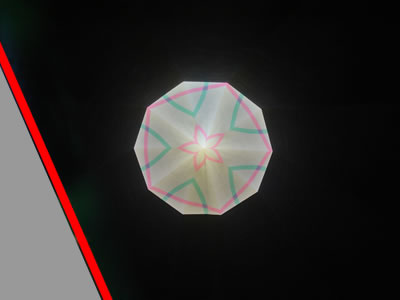 This is a
five point mandala. In this view you can fully see the image.
This is a
five point mandala. In this view you can fully see the image. Designing Two Mirror Kaleidoscopes
When designing mirror systems for kaleidoscopes, there is a relation between mirror width and length that should be followed to create a pleasing image. It is very difficult to give solid recommendations because the acceptable ratio can change depending on the angle of the mirror system and your personal choice of image preferences. It has been found that the width to length ratios ranging from 1:4 to 1:6 can work well.
I feel that a kaleidoscope image suffers when you cannot see the complete mandala image without changing your eye position while viewing a scope. The central image should be framed with a small black background with the colorful mandala image placed in the center. I also think that the kaleidoscope image suffers when it appears that you are looking into a long black tube, where you see a majority of black and a small colorful image in the center. By understanding and maintaining a good ratio, these image problems can be avoided.
My personal rule of thumb falls within what Sir David Brewster found. The width to length ratio of 1:6 ratio works very well for most angles often used in a kaleidoscope. In very plain english, the width of the mirrors is one sixth of the length, or you could say that the length of the mirrors are 6 times longer than the width.
I have assembled a group of photos below to illustrate the effects of changing the ratio of the width to length of the mirrors. The camera lens was placed right against the edge of the mirrors. The zoom feature was not used. The red lines are the edges of the mirrors. The outside edges have been grayed out for clarity. Images have been resized to 400 pixel. No cropping of the original images.
 This is a
five point mandala. In this view you can fully see the image.
This is a
five point mandala. In this view you can fully see the image.
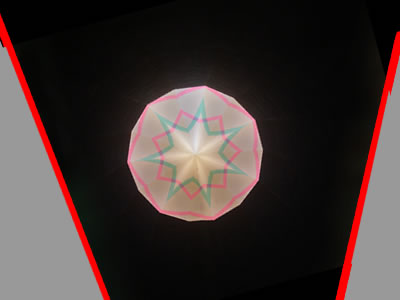 This
is a seven point mandala using the same 1/6 ratio.
This
is a seven point mandala using the same 1/6 ratio.
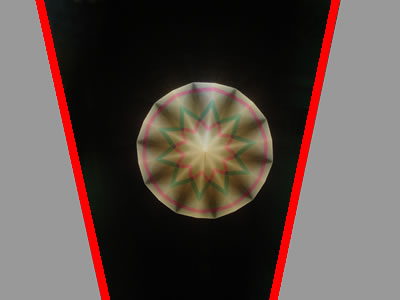 This
is a ten point mandala using the same 1/6 ratio. As you can clearly see, there is
a nice border on all of the images.
This
is a ten point mandala using the same 1/6 ratio. As you can clearly see, there is
a nice border on all of the images.
 The
five point mandala still looks good.
The
five point mandala still looks good.
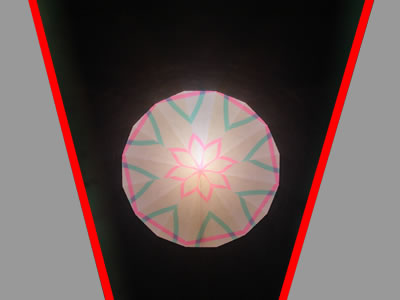 The
eight point mandala is still looking ok here in this picture. The border is closing
in, and it is getting harder to see the complete image.
The
eight point mandala is still looking ok here in this picture. The border is closing
in, and it is getting harder to see the complete image.
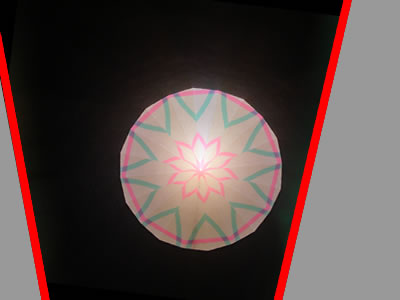 In this ten point
mandala image, the camera is doing a better job than the human eye. The border is
getting very tight, but the image can still be seen.
In this ten point
mandala image, the camera is doing a better job than the human eye. The border is
getting very tight, but the image can still be seen.
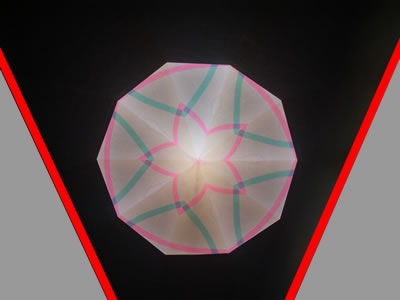 The
five point Mandala can still be seen, however the image background is getting very
small.
The
five point Mandala can still be seen, however the image background is getting very
small.
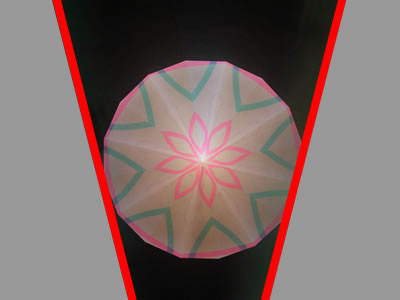 The image is now
being cut off by the edges of the mirror. You can no longer see the entire image
without shifting your eye to see the complete image. Placing the eye hole further
from the apex you can improve your view at the cost of losing good symmetry.
The image is now
being cut off by the edges of the mirror. You can no longer see the entire image
without shifting your eye to see the complete image. Placing the eye hole further
from the apex you can improve your view at the cost of losing good symmetry.
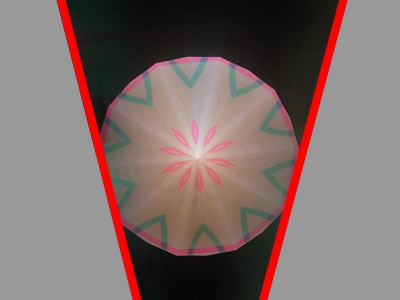 The image is blocked
by the mirrors. This is clearly a result of the limited length of the mirror length
and should be avoided in my opinion.
The image is blocked
by the mirrors. This is clearly a result of the limited length of the mirror length
and should be avoided in my opinion.
The mirror width to length ratio is something to watch out for. If the ratio is too large or too small, the image will suffer.
From the images above, we can determine these simple rules:
There are several things to note about using large ratios which result in longer than 8" mirror sets. There is a slight increase in cost of mirror materials since you are using more mirror per scope. There is an increased surface area in the mirror system that gives more chances of showing and collecting dust. The longer the mirrors are, the higher the chances are of bending the mirrors during assembly causing a warped image in one sector of the mandala. This problem can be avoided by using thicker mirror, but it comes at a much higher cost for mirror. The overall weight of the scope can also be an added problem.
On the plus side, you do not need a lens for most 10"-12" long mirror systems. The images will look extremely large compared to what people normally get to see in most galleries. Larger eye holes can be used. Many collectors value the larger scopes, and it's the next step to making parlor style scopes.
From the above information one could extract these numbers:
| Width | Length | Tube ID | |||
| 1:6 | 1:5 | 1:4 | |||
| 1/2 | 3 | 2 1/2 | 2 | 0.625 | |
| 5/8 | 3 3/4 | 3 1/8 | 2 1/2 | 0.781 | |
| 3/4 | 4 1/2 | 3 3/4 | 3 | 0.938 | |
| 7/8 | 5 1/4 | 4 3/8 | 3 1/2 | 1.094 | |
| 1 | 6 | 5 | 4 | 1.250 | |
| 1 1/8 | 6 3/4 | 5 5/8 | 4 1/2 | 1.406 | |
| 1 1/4 | 7 1/2 | 6 1/4 | 5 | 1.563 | |
| 1 3/8 | 8 1/4 | 6 7/8 | 5 1/2 | 1.719 | |
| 1 1/2 | 9 | 7 1/2 | 6 | 1.875 | |
| 1 5/8 | 9 3/4 | 8 1/8 | 6 1/2 | 2.031 | |
| 1 3/4 | 10 1/2 | 8 3/4 | 7 | 2.188 | |
| 1 7/8 | 11 1/4 | 9 3/8 | 7 1/2 | 2.344 | |
| 2 | 12 | 10 | 8 | 2.500 | |
| 2 1/8 | 12 3/4 | 10 5/8 | 8 1/2 | 2.656 | |
| 2 1/4 | 13 1/2 | 11 1/4 | 9 | 2.813 | |
| 2 3/8 | 14 1/4 | 11 7/8 | 9 1/2 | 2.969 | |
| 2 1/2 | 15 | 12 1/2 | 10 | 3.125 |
*Note: All dimensions given in inches. Tube ID is a general size for mirror systems three point and higher. Thickness of mirror and third side may effect sizing. Blame Excel and my poor math skills for any errors. I have not made any effort to check these numbers but they look right to me.
This document is the results of a message posted by Frank Higgins in the Yahoo Group KBKB message #5970. He brings up several issues in using a lower ratio. I would encourage you to take a look at the message for a greater understanding.
I hope this helps someone when it comes time to develop a new two mirror system in a kaleidoscope. If you have any question or see any errors, please feel free to contact me.
© 1/10/2009, Artscopes.com, Timothy Krause